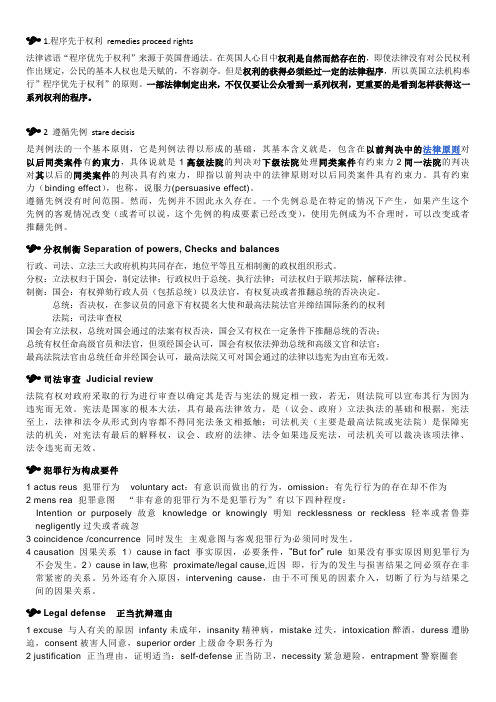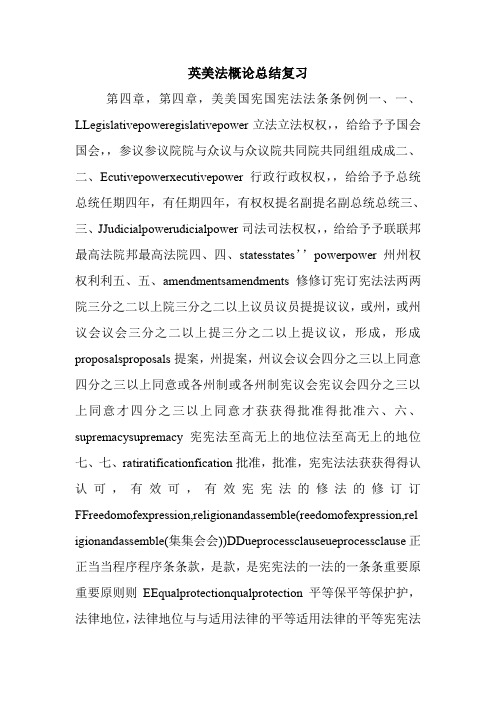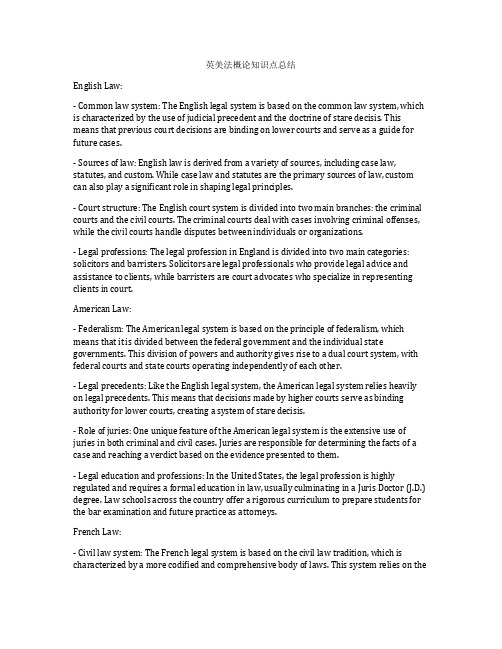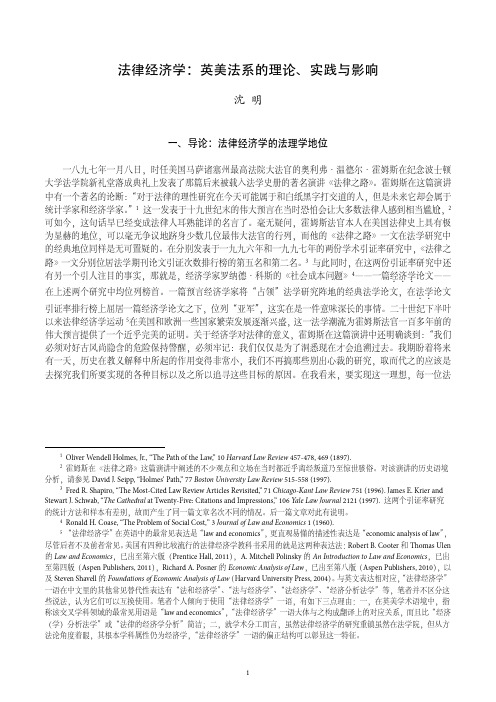英美法导论
英美法概论

1.程序先于权利remedies proceed rights法律谚语“程序优先于权利”来源于英国普通法。
在英国人心目中权利是自然而然存在的,即使法律没有对公民权利作出规定,公民的基本人权也是天赋的,不容剥夺。
但是权利的获得必须经过一定的法律程序,所以英国立法机构奉行”程序优先于权利”的原则。
一部法律制定出来,不仅仅要让公众看到一系列权利,更重要的是看到怎样获得这一系列权利的程序。
2 遵循先例stare decisis是判例法的一个基本原则,它是判例法得以形成的基础,其基本含义就是,包含在以前判决中的法律原则对以后同类案件有约束力,具体说就是1高级法院的判决对下级法院处理同类案件有约束力2同一法院的判决对其以后的同类案件的判决具有约束力,即指以前判决中的法律原则对以后同类案件具有约束力。
具有约束力(binding effect),也称,说服力(persuasive effect)。
遵循先例没有时间范围。
然而,先例并不因此永久存在。
一个先例总是在特定的情况下产生,如果产生这个先例的客观情况改变(或者可以说,这个先例的构成要素已经改变),使用先例成为不合理时,可以改变或者推翻先例。
分权制衡Separation of powers, Checks and balances行政、司法、立法三大政府机构共同存在,地位平等且互相制衡的政权组织形式。
分权:立法权归于国会,制定法律;行政权归于总统,执行法律;司法权归于联邦法院,解释法律。
制衡:国会:有权弹劾行政人员(包括总统)以及法官,有权复决或者推翻总统的否决决定。
总统:否决权,在参议员的同意下有权提名大使和最高法院法官并缔结国际条约的权利法院:司法审查权国会有立法权,总统对国会通过的法案有权否决,国会又有权在一定条件下推翻总统的否决;总统有权任命高级官员和法官,但须经国会认可,国会有权依法弹劲总统和高级文官和法官;最高法院法官由总统任命并经国会认可,最高法院又可对国会通过的法律以违宪为由宣布无效。
国际商法复习重点

国际商法复习一、导论:英美法系法的主要渊源、法律划分、分布国家等国际商法的特点:商事性(商整体&商行为)、国际性、调整范围广、法律和惯例的综合体西方国家民商法的基本原则1)权利能力平等;2)私有财产神圣不可侵犯;3)契约自由英美法系(又称普通法系):特征:没有成文法典、公法私法之分;重程序法轻实体法、重判例轻条文分布国家:加拿大、澳大利亚、新西兰、爱尔兰、印度、巴基斯坦、马来西亚、新加坡、香港。
不包括:日本、苏格兰、美国&加拿大的某一小部分1.英国法结构:普通法、衡平法、制定法2.美国法以判例为基础。
制定法比重>普通法特点:分为联邦法、州法(州最高法院对本州案件有终审权)3.英美法的两大特征——遵循先例、救济(程序)优先于权利遵循先例:先例不只是必须遵守的示范模式,也是对后来案件具有法律约束力的判例。
救济先于权利:救济指通过一定诉讼程序给与当事人以法律上的保护。
救济优先属于程序法范畴,权利属于实体法范畴,当事人先有程序权利才有实体权利。
主要渊源:1、判例法。
主要特点:先例约束力原则。
判决理由对做出判例的法院本身和对下级法院日后处理同类案件具有约束力。
第一,判例的约束力是与法院的等级结构相联系的:其一,上级法院的判例对下级法院有约束力。
英国上议院的判决对任何等级的英国法院有约束力;上诉法院的判决对高等法院和它以下的法院具有约束力;高等法院的判决对郡法院具有约束力。
其二,同一法院或同一级法院的判例具有约束力。
在特定条件下上议院可以不必遵循自己先前的判决;上诉法院也受本院以及同一级的固有的法院判例的约束,一般也不允许擅自将其变更。
高等法院原则上也是受本院或同一级固有法院判例的约束,其三,下级法院的判例对上级法院没有约束力第二,遵循先例主要指遵守判决理由。
判例由“判决理由”(ratio decidendi)和“附带意见”(obiter dicta )两部分组成。
判决理由是判决的依据和核心,其主要包括两个内容:判决中关系重大的事实;根据重大事实提出的法律上的判断。
英美法系的基本原理

04
英美法系的法律适用
司法审判的原则
遵循先例原则
英美法系中,法院在审理案件时会遵循先前类似案件的判决结果,即先例。先例对下级法 院具有约束力,有助于维护法律的稳定性和可预测性。
陪审团制度
在英美法系中,陪审团在审判中发挥着重要作用。陪审员由普通公民组成,负责对案件事 实进行认定。这一制度体现了民众参与司法的精神,有助于增强司法公信力。
演绎推理
从一般到个别的推理过程,根据已知的法律原则或规则,推导出具体案件的判决结果。这种推理方法强调法律原则或 规则的适用性和普遍性。
类比推理
将当前案件与先前类似案件进行比较,根据先例中的法律原则或规则,推断出当前案件的判决结果。这 种推理方法体现了英美法系中遵循先例原则的精神。
05
英美法系的法律教育与研究
02
英美法系的法律渊源
普通法
判例法
普通法是以判例为基础的法律体 系,法官在审理案件时会遵循先 例原则,即以前类似案件的判决 结果对当前案件具有约束力。
法官造法
在普通法体系中,法官不仅适用 法律,还在一定程度上创造法律 。他们通过解释和适用判例来发 展法律规则。
制定法
成文法
制定法是由立法机关制定的成文法规 ,具有明确的条款和规定。在英美法 系中,制定法与普通法并存,相互补 充。
管辖区,各地法官在审理案件时逐渐形成了一套统一的法律原则。
02
17-18世纪的变革
17-18世纪,英国进行了资产阶级革命和产业革命,社会结构和经济关
系发生了深刻变化,普通法也随之进行了相应的调整和完善。
03
19世纪以来的传播与发展
19世纪以后,随着英国的殖民扩张和国际贸易的发展,英美法系逐渐传
英美法概论总结复习.doc

英美法概论总结复习第四章,第四章,美美国宪国宪法法条条例例一、一、LLegislativepoweregislativepower立法立法权权,,给给予予国会国会,,参议参议院院与众议与众议院共同院共同组组成成二、二、Ecutivepowerxecutivepower行政行政权权,,给给予予总统总统任期四年,有任期四年,有权权提名副提名副总统总统三、三、JJudicialpowerudicialpower司法司法权权,,给给予予联联邦最高法院邦最高法院四、四、statesstates’’powerpower州州权权利利五、五、amendmentsamendments修修订宪订宪法法两两院三分之二以上院三分之二以上议员议员提提议议,或州,或州议会议会三分之二以上提三分之二以上提议议,形成,形成proposalsproposals提案,州提案,州议会议会四分之三以上同意四分之三以上同意或各州制或各州制宪议会宪议会四分之三以上同意才四分之三以上同意才获获得批准得批准六、六、supremacysupremacy宪宪法至高无上的地位法至高无上的地位七、七、ratiratificationfication批准,批准,宪宪法法获获得得认认可,有效可,有效宪宪法的修法的修订订FFreedomofexpression,religionandassemble(reedomofexpression,rel igionandassemble(集集会会))DDueprocessclauseueprocessclause正正当当程序程序条条款,是款,是宪宪法的一法的一条条重要原重要原则则EEqualprotectionqualprotection平等保平等保护护,法律地位,法律地位与与适用法律的平等适用法律的平等宪宪法的基本原法的基本原则则fundamentalprinciplesfundamentalprinciples11FFederalismederalis m联联邦制邦制22NNecessaryandproperecessaryandproper国会为国会为行使上述行使上述权权利,有利,有权权立法立法州州权权利利powerofstatespowerofstates没没有授予有授予给联给联邦的邦的权权力及在州力及在州没没有禁止的有禁止的权权利中由州享有,利中由州享有,为为residualstatepowerresidualstatepower剩余剩余权权力力33SSeparationofpowerseparationofpowers分分权权checksandbalanceschecksandbalances制衡制衡LLegislatureegislature立法机立法机关关属属于于国会国会cutivecutive行政部行政部门门总统总统及行政官及行政官员员,,执执行法律行法律JJudiciaryudiciary司法部司法部门门,最高法院,解,最高法院,解释释法律法律judicialreviewjudicialreview司法司法审查审查通通过过判例法形成判例法形成规规范的一范的一项项制衡措施制衡措施第五章第五章,,刑法刑法一、一、构构成犯罪行成犯罪行为为的要素的要素1,actusreus1,actusreus犯罪行犯罪行为为,包括,包括voluntaryvoluntaryactact有意有意识识作出的行作出的行为为和和omissionomission不作不作为为,存在法律上的,存在法律上的义务义务可是不作可是不作为为而而导导致犯罪的致犯罪的发发生生,,22,,mensreamensrea犯罪意犯罪意图图,也叫犯意,四,也叫犯意,四种种犯意,由高到低分犯意,由高到低分为为,,intentionintentionorpurposelyorpurposely故意,故意,knowledgeknowledgeorknowinglyorknowingly明知,采取放任明知,采取放任态态度度,,recklessnessorrecklesslyrecklessnessorrecklessly轻轻率率鲁鲁莽(莽(极极端端轻轻率有可能入罪),率有可能入罪),negligentlynegligently过过失疏忽(一般失疏忽(一般过过失不失不会会追究刑事追究刑事责责任)任)3,coincidenceconcurrence3,coincidenceconcurrence同同时发时发生在犯罪生在犯罪与与犯意之犯意之间间具有具有同同时时性性44,,causationcausation因果因果关关系系causeinfactcauseinfact事事实实原因(若不是原因(若不是这个这个行行为为就就不不会导会导致致这个结这个结果)果)causeinlawcauseinlaw法律原因法律原因二、二、legaldefenselegaldefense合法合法辩护辩护11,,excuseexcuse可得可得宽宽恕,如未成年,精神失常等恕,如未成年,精神失常等22,,justificationjustification正正当当理由,理由,证证明适明适当当,如正,如正当当防防卫卫,,紧紧急避急避险险等等33,,intoxicationintoxication酗酒,酗酒,voluntaryintoxicationvoluntaryintoxication自愿醉自愿醉态态不可不可辩护辩护,,involuntaryintoxicationinvoluntaryintoxication非自愿醉非自愿醉态态可可辩护辩护44,,mistakemistake错误错误法律法律错误错误和事和事实错误实错误55,,duduressress 胁胁迫,迫,不适用于不适用于murdermurder谋杀谋杀和和treasontreason叛叛国国罪罪66,,consentofthevictimconsentofthevictim受害人同意受害人同意,如安,如安乐乐死死77,,entrapmententrapment警察圈套警察圈套三、三、majorcrimesmajorcrimes主要罪行主要罪行英:(罪行英:(罪行轻轻重)重)treasontreason叛叛国国罪,罪,felonyfelony 重罪,重罪,misdemeanormisdemeanor轻轻罪罪美:(美:(诉讼诉讼程序)程序)summaryoffencesummaryoffence即即决决罪,罪,indictableoffenceindictableoffence可可诉讼诉讼罪,罪,hybridoffencehybridoffence混合程序罪混合程序罪几几种种罪行:罪行:A,A,HHomicideomicide杀杀人罪人罪,,分分为为11,,murdermurder预谋杀预谋杀人,人,传统内传统内涵涵::maliceaforethoughtmaliceaforethought预谋杀预谋杀人人现现代代类类型:型:IIntenttokillmurderntenttokillmurder预谋杀预谋杀人人IIntenttodoseriousbodilyinjurymurderntenttodoseriousbodilyinjurym urder预谋预谋重重伤伤致死致死RRecklessindifferencetovalueofhumanlifeordepravedheartecklessind ifferencetovalueofhumanlifeordepravedheartmurdermurder极极端端轻轻率率谋杀谋杀FFelonymurderelonymurder重罪重罪谋杀谋杀DDegreeegree::FFirstdegreemurderirstdegreemurder一一级谋杀级谋杀(一(一级谋杀级谋杀及部分重罪及部分重罪谋杀谋杀)可判死)可判死刑刑SSeconddegreemurdereconddegreemurder二二级谋杀级谋杀(故意重(故意重伤谋杀伤谋杀,,极极端端轻轻率率谋杀谋杀,,部分重罪部分重罪谋杀谋杀)死刑以下,即)死刑以下,即终终身身监监禁及以下禁及以下22,,manslaughtermanslaughter非非预谋杀预谋杀人人voluntarymanslaughtervoluntarymanslaughter非非预谋预谋故意故意杀杀人人involuntarymanslaughterinvoluntarymanslaughter非非预谋过预谋过失失杀杀人人B,physicalinjuryB,physicalinjury伤伤害罪分害罪分为为BBatteryattery殴殴打打AAssaultssault企企图伤图伤害害MMayhemayhem重重伤伤C,burglaryC,burglary夜夜盗盗罪,罪,怀怀着着实实施重罪的意施重罪的意图图在在夜里打夜里打开并进开并进入他人住入他人住宅宅的行的行为为第六章,第六章,proceduralprocedurallawlaw诉讼诉讼法法英美英美诉讼诉讼制度的特点:制度的特点:AAdversarysystemdversarysystem对对抗制抗制PProcedureorientedrocedureoriented追求程序上的正追求程序上的正当当JJurysystemurysystem陪陪审团审团制度制度一、一、民事民事诉讼诉讼civilprocedurecivilprocedure11,,prepre--trialproceduretrialprocedure审审前程序前程序pleadingpleading诉诉答程序答程序plaintiffplaintiff原告原告filesacomplaintfilesacomplaint提交提交诉状诉状courtcourt法院法院向被告(向被告(defendantdefendant))发发出出传传票(票(summonsummon))defendantdefendant被告被告admissionadmission承承认认罪罪状状或或answeranswer答答辩状辩状或者或者councounterclaimterclaim反反诉诉(如果(如果对对原告有原告有诉讼诉讼))22,,discoverydiscovery证证据据开开示程序示程序33,,pretrialconferencepretrialconference审审前前会议会议44,,settlement/ADRsettlement/ADR和解和解与与替代程序替代程序55,,trialtrial审审理理A,juryA,jury((传统传统上上1212人,人,现现在最少在最少66人)人)trialtrial陪陪审员审审员审判判挑挑选选陪陪审员审员HHearingandinstructionearingandinstruction听听审审DDeliberationandverdicteliberationandverdict议议事事审审判(判(联联邦需一直裁邦需一直裁决决,州不一定),州不一定)B,B,BBenchtrialenchtrial法院法院审审理理OOpeningstatementpeningstatement开开庭庭陈陈述,先原告后述,先原告后被告被告PPresentationresentation举证举证CClosingargumentlosingargument/statement/summation/statement/s ummation结结案呈案呈辞辞C,judgmentC,judgment判判决决MMoneydamageoneydamage金金钱损钱损害害赔偿赔偿EEquitablereliefquitablerelief衡平救衡平救济济(禁令(禁令injunctioninjunction或或实际实际履行履行specificspecificperanceperance))DDeclaratoryreliefeclaratoryrelief宣告式救宣告式救济济AAwardsofcostswardsofcosts诉讼费诉讼费用解用解决决二、二、刑事刑事诉讼诉讼criminalprocedurecriminalprocedure11,,PPretrialproceedingsretrialproceedings审审前程序前程序AArrestrrest逮捕(有逮捕(有证证无无证证逮捕逮捕warrantwarrant或或probablecauseprobablecause可能性根可能性根据)据)BBookingooking登登记记FFilingcomplaintilingcomplaint提起指控确定罪行提起指控确定罪行IInitialappearancenitialappearance初次聆初次聆讯讯,到庭,到庭PPreliminaryhearingreliminaryhearing预审预审听听证证IIndictmentndictment控告控告AArraignmentrraignment传讯传讯,提,提审审33,,pleabargain/negotiation/agreementpleabargain/negotiation/agreemen t变诉变诉交易交易pleadtoalessseriouschargepleadtoalessseriouscharge指控,罪名交易(指控,罪名交易(认认一一个个更更轻轻的罪)的罪)罪罪数数交易交易((检检察官承察官承诺诺))刑刑罚罚交易(交易(对对所控罪所控罪认认罪,罪,检检察官向法官建察官向法官建议减轻议减轻刑刑罚罚))44,,trialandsentencingtrialandsentencingjuryselectionjuryselectionproofp roof三、三、证证据据evidenceevidence1,1,分分类类::RRealevidenceealevidence实实物物证证据据DDocumentaryevidenceocumentaryevidence书书面面证证据据TTestimonialevidenceestimonialevidence证证人人证证言言JJudicialnoticeudicialnotice司法司法认认知知2,2,分分类类::DDirectevidenceirectevidence直接直接证证据据CCircumstantialevidenceircumstantialevidence情形情形证证据据3,3,证证明明责责任任burdenburdenofproofofproof ((burdenofproductionburdenofproduction提出提出证证据据责责任任burdenofpersuasionburdenofpersuasion说说服服证证据据责责任):任):民事中,民事中,谁谁主主张谁举证张谁举证,原告,原告刑事中刑事中,,对对于于构构成要件成要件来说来说,公,公诉检诉检察官察官举证举证;被告;被告积极积极抗抗辩时辩时,,被告被告举证举证。
英美法导论general introduction-66页精选文档

Lynn M. Lin lexlinmingmail Mar - June. 2019
Overview
Unit One
The Origins of English Law
1、Iberians 伊比利亚人
2、Beak Folk 比克人/宽口陶器人
•描述:来自荷兰和德国的莱茵河畔/强悍好战/巨石群
巨石群
3500BC, Salisbury, England,to predict events of the solar calendar. 比克人留下的唯一记录
The Celts/凯尔特人 (分三批入侵)/来自荷兰和莱茵河畔
后来,比克人Beak Folk 到来了,打败伊比利亚人。在这里里居住。 凯尔特人(the Celts)的3次入侵(3个部族的人侵)。凯尔特人中的最先使用青铜 器的盖尔族(the Gaels),所以先入侵。继而使用铁器的布来顿人(the Brythons)一 直攻打到了威尔士、苏格兰、爱尔兰。 最后入侵的是比利奇族(the Belgae)善战把当地的先入侵的凯尔特人征服,定居不 列颠南部,把不列颠动南部建设成为岛上的政治经济中心并与欧洲大陆开展贸易往来。 其余部族的凯尔特人只好往西进入爱尔兰,并且往北开进苏格兰高地。 不列颠的名字是由于布赖顿人的入侵和扩张而得来的。
综述:
观念:带来了日尔曼部族的一条共同法则:通过金钱的力量维护人们之间的法律关系。
•The Origins of the Nation •Common Law •Equity
The Origins of the US Law
英美法概论知识点总结

英美法概论知识点总结English Law:- Common law system: The English legal system is based on the common law system, which is characterized by the use of judicial precedent and the doctrine of stare decisis. This means that previous court decisions are binding on lower courts and serve as a guide for future cases.- Sources of law: English law is derived from a variety of sources, including case law, statutes, and custom. While case law and statutes are the primary sources of law, custom can also play a significant role in shaping legal principles.- Court structure: The English court system is divided into two main branches: the criminal courts and the civil courts. The criminal courts deal with cases involving criminal offenses, while the civil courts handle disputes between individuals or organizations.- Legal professions: The legal profession in England is divided into two main categories: solicitors and barristers. Solicitors are legal professionals who provide legal advice and assistance to clients, while barristers are court advocates who specialize in representing clients in court.American Law:- Federalism: The American legal system is based on the principle of federalism, which means that it is divided between the federal government and the individual state governments. This division of powers and authority gives rise to a dual court system, with federal courts and state courts operating independently of each other.- Legal precedents: Like the English legal system, the American legal system relies heavily on legal precedents. This means that decisions made by higher courts serve as binding authority for lower courts, creating a system of stare decisis.- Role of juries: One unique feature of the American legal system is the extensive use of juries in both criminal and civil cases. Juries are responsible for determining the facts of a case and reaching a verdict based on the evidence presented to them.- Legal education and professions: In the United States, the legal profession is highly regulated and requires a formal education in law, usually culminating in a Juris Doctor (J.D.) degree. Law schools across the country offer a rigorous curriculum to prepare students for the bar examination and future practice as attorneys.French Law:- Civil law system: The French legal system is based on the civil law tradition, which is characterized by a more codified and comprehensive body of laws. This system relies on theapplication of enacted laws and legal codes, as opposed to the reliance on judicial precedent seen in common law systems.- Role of judges: In the French legal system, judges play a significant role in applying the law to specific cases. They are responsible for interpreting and enforcing the law, and they often have more discretion in making decisions than judges in common law systems.- Legal codes: French law is heavily reliant on written legal codes, with the most famous being the Napoleonic Code, which was enacted in 1804 and serves as the foundation of many civil law systems around the world.- Legal professions: The legal profession in France is divided into two main categories: avocats and magistrats. Avocats are legal professionals who provide legal representation and advice to clients, while magistrats are judges who preside over court proceedings and make decisions in accordance with the law.Comparative Analysis:- Legal principles and values: Despite the differences in their legal systems, all three countries share certain fundamental legal principles and values, such as the rule of law, protection of individual rights, and the separation of powers.- Role of the judiciary: In all three countries, the judiciary plays a crucial role in interpreting and applying the law to specific cases. However, the degree of judicial discretion and the reliance on legal precedents vary between the common law and civil law systems.- Legal education and training: While all three countries require a formal education in law for individuals to practice as attorneys, there are differences in the structure and content of legal education programs. For example, the emphasis on case law in common law countries and codified law in civil law countries.- Legal professions and courts: The organization and structure of legal professions and courts also differ between English, American, and French legal systems. These differences reflect the historical, cultural, and political contexts in which these legal systems have developed.Conclusion:In conclusion, the legal systems of England, America, and France each have distinct features and characteristics that reflect their unique historical, cultural, and political contexts. While there are common principles and values that underpin all three legal systems, there are also significant differences in their sources of law, court structures, legal professions, and approaches to legal education. Understanding these differences is essential for lawyers, judges, and legal scholars to navigate the complexities of the global legal landscape and promote cross-cultural understanding and cooperation.。
英美法的历史发展-PPT文档资料

第四,衡平法上之不得自食其言。如果契约一方通知另一方 他放弃某项合法权利,在某些情况下,他不得违背此种诺言
第五,禁令。禁止当事人为某种行为。 第六,特别履行。强制履行契约的命令。它只适用于普通法
衡平法产生原因:
第一,新的社会需要
第二,普通法的僵化
首先,是令状形式的僵化。
其次,普通法的内容僵化。普通法主要是 土地法,而缺少关于动产和债的内容。
再次,救济方式的僵化。普通法以损害赔 偿为主,救济方式单一而缺乏灵活性。
令状
令状是由大法官以国王的名义颁发的要求接 受令状者到法院接受审判的书面命令。
巡回审判制度
英王威廉一世、威廉二世为了加强对地方上的控制, 都不时地派遣王室官员巡视全国(巡抚)。
亨利一世统治时期,这种巡视制度逐渐演变为巡回 审判,但是这种巡回审判还没有确定的时间和明确 的分工,没有制度化、规范化和定期化。
亨利二世(1154-1189,英格兰习惯法之父)时进 行了重大的司法改革,建立起真正的、永久性的巡 回审判制度:1176年北安普顿诏令把全国分为六个 巡回审判区,各设一个巡回法庭;1179年温莎诏令 将巡回审判变成定期和永久性制度。到亨利三世时 形成每年巡回全国两次的惯例。这就建立了永久性 巡回审判制度。
另外,最初的几个世纪,衡平法并无遵循先例的要 求,只要求大法官根据“公平”“正义”、“良心” 断案,大法官具有极大的自由裁量权。直到十七世 纪后,衡平法才接受了先例原则。
衡平法是为弥补普通法的缺陷而发展起来,是 对普通法的补充。从涵盖范围看,普通法是全 方位的,而衡平法只关注那些普通法调整不力 的方面。从救济方式看,普通法以损害赔偿为 主,适用范围广泛;而衡平法只有在普通法的 救济方法不足以弥补当事人的损失时才能发挥 作用。
法律经济学:英美法系的理论、实践与影响

法律经济学:英美法系的理论、实践与影响沈明一、导论:法律经济学的法理学地位一八九七年一月八日,时任美国马萨诸塞州最高法院大法官的奥利弗·温德尔·霍姆斯在纪念波士顿大学法学院新礼堂落成典礼上发表了那篇后来被载入法学史册的著名演讲《法律之路》。
霍姆斯在这篇演讲中有一个著名的论断:“对于法律的理性研究在今天可能属于和白纸黑字打交道的人,但是未来它却会属于统计学家和经济学家。
”1这一发表于十九世纪末的伟大预言在当时恐怕会让大多数法律人感到相当尴尬,2可如今,这句话早已经变成法律人耳熟能详的名言了。
毫无疑问,霍姆斯法官本人在美国法律史上具有极为显赫的地位,可以毫无争议地跻身少数几位最伟大法官的行列,而他的《法律之路》一文在法学研究中的经典地位同样是无可置疑的。
在分别发表于一九九六年和一九九七年的两份学术引证率研究中,《法律之路》一文分别位居法学期刊论文引证次数排行榜的第五名和第二名。
3与此同时,在这两份引证率研究中还有另一个引人注目的事实,那就是,经济学家罗纳德·科斯的《社会成本问题》4——一篇经济学...论文——在上述两个研究中均位列榜首。
一篇预言经济学家将“占领”法学研究阵地的经典法学论文,在法学..论文引证率排行榜上屈居一篇经济学论文之下,位列“亚军”,这实在是一件意味深长的事情。
二十世纪下半叶以来法律经济学运动5在美国和欧洲一些国家繁荣发展逐渐兴盛,这一法学潮流为霍姆斯法官一百多年前的伟大预言提供了一个近乎完美的证明。
关于经济学对法律的意义,霍姆斯在这篇演讲中还明确谈到:“我们必须对好古风尚隐含的危险保持警醒,必须牢记:我们仅仅是为了洞悉现在才会追溯过去。
我期盼着将来有一天,历史在教义解释中所起的作用变得非常小,我们不再搞那些别出心裁的研究,取而代之的应该是去探究我们所要实现的各种目标以及之所以追寻这些目标的原因。
在我看来,要实现这一理想,每一位法1Oliver Wendell Holmes, Jr., “The Path of the Law,” 10 Harvard Law Review 457-478, 469 (1897).2霍姆斯在《法律之路》这篇演讲中阐述的不少观点和立场在当时都近乎离经叛道乃至惊世骇俗。
外国法制史之英美.ppt

▪ 第十讲、英国法 ▪ 重点问题: ▪ 1、普通法和衡平法的形成和发展 ▪ 2、普通法的特点和原则 ▪ 3、衡平法的特点和影响 ▪ 4、英国宪法的基本原则 ▪ 5、英国的陪审制度和律师辩护制度
▪ 一、英国法的形成和发展:
▪ 1、诺曼征服前(5世纪-1066年)盎格 鲁·撒克逊习惯法到成文化阶段“蛮族法 典”。
▪ 选举制的改革,增加资产阶级名额,财产限制放松,公 开投票制。
▪ 制定法数量大增; ▪ 对法院组织和程序法进行改革,1873年、1875年《司法
法》结束了普通法院和衡平法院分立对峙局面。
▪ 5、当代英国法的发展: ▪ 立法程序简化,委托立法大增; ▪ 完善选举制; ▪ 社会立法加强; ▪ 欧盟法成为英国法的重要渊源。
▪ 3、英国宪法的特点: ▪ (1)历史延续性 ▪ (2)内容不确定性 ▪ (3)柔性宪法
▪ 四、行政法: ▪ 1、行政法概念—支配行政活动的法律。没有公法和私法
之分。 ▪ 2、行政法特点—由普通法院管辖,没有行政法院系统;
适用一般法律原则。 ▪ 3、基本原则: ▪ 越权无效; ▪ 行政行为合理原则:以公共利益和正当理由为依据,防
▪ 遗嘱继承书面形式,由遗嘱人签字或在其监督下他人代签, 两个证人证实。
▪ 1938年前遗嘱绝对自由,后规定未亡配偶、未成年子女或 无生活能力的子女有权得到必要的保障;非婚生子女也从 遗产中可获得抚养费。
▪ 无遗嘱继承人生存配偶、生存子女、生存父母、其他近亲, 无主归国家所有。
▪ 九、刑法: ▪ 1、概述 ▪ 至今仍然没有成文刑法典。 ▪ 盎格鲁·撒克逊时代就存在血亲复仇或赎罪金的方
▪ 二、英国法的渊源: ▪ 1、普通法:指由普通法院创立并发展起来的一
英美法概论(最新版本)

英美法概论第一章普通法本章将介绍英美法的重要法源——普通法,包括普通法的基本含义、形成的原因以及学术观点。
重点是普通法形成原因之分析。
第一节普通法的含义一、普通法的含义(一)关于对common law的翻译“习惯法”抑或“普通法”?(二)普通法的含义1.原始含义:是指在13世纪爱德华一世时期形成的与地方习惯法相对称,在王室法院适用的通行于全英国的“习惯法”。
来源于教会法的jus commune,lex communis2.普通法的现代含义(1)与衡平法相对称即指原始含义上的普通法。
指从13世纪形成的在全英国普遍适用的共同的习惯法。
即由英国早期王室法院适用的通行于全国的习惯法。
(2)与制定法相对称,普通法就是判例法。
(3)与其他国家的法律相对称,普通法就是指英国法。
(4)与大陆法相对称,指与大陆法相对立的整个英美法。
包括普通法、衡平法、制定法。
二、与普通法相关的几个概念(一)判例法(case law)既指一种法律方法,也指一种法律.从法律方法角度讲,判例法是“是根据法院和法庭以往对特定案件所作司法决定而对其中设定的法律原则和规则进行概括的普遍术语。
从法渊角度讲,判例法是汇编判例的集合或者是作为证据的特定主题的法律,或者是由已决案件形成的法律,区别于制定法和其他法律渊源。
(二)案件(case)《布莱克法律字典》对“case”有不同含义广义理解上既包括已决案件,也包括未决案件。
狭义理解上,“案件”较为合适。
(三)先例(precedent)先例是“法院做出的决定或已决案件。
为后来出现的类似或相近案件提供了范例或者效力。
法院在先前案件中确立的原则基础上审理案件,在事实或法律原则上与待决案件相似的先前案件即为先例(四)遵循先例(stare decisis)遵循先例是适用判例法的原理或者规则。
第二节普通法的形成一、普通法形成的学术观点(一)国内关于普通法形成的主流学说普通法的形成与英格兰国王政府在司法领域的中央集权化的尝试分不开,1066年“诺曼征服”以后,原有的各地分散的习惯法给统一的全国管理带来了很大的不便和困难。
2011英美法导论资料

2011英美法导论资料A1,案例分析U.S. Supreme Court:Terry v. Ohio 392 U.S. 1 (1968)STA TEMENT OF THE CASE: The D contended that the weapon seized from his person and introduced into evidence was obtained through an illegal search, under the Fourth Amendment, and that the trial court improperly denied his motion to suppress.PROCEDURE BELOW: Petitioner sought review of a judgment from the Supreme Court of Ohio that affirmed petitioner's lower court conviction for carrying a concealed weapon.STA TEMENT OF THE FACTS: An officer observed two men standing on a street corner. One would walk up to a store window, look inside, and return to confer with his companion. This process was repeated about a dozen times. The suspects talked with a third man, then followed him up the street. Thinking the suspects were "casing" the store, the officer confronted the three men and asked their names. The men mumbled a response, at which time the officer spun one of the men, Terry (D), around and patted his breast. He found and removed a pistol. D was charged with carrying a concealed weapon. D moved to suppress this weapon from evidence. The trial judge denied his motion. The Ohio court of appeals affirmed, and the state supreme court dismissed D's appeal.LEGAL ISSUE: Is it always unreasonable for a policeman to seize a person and subject him to a limited search for weapons when there is no probable cause for arrest?HOLDING: An officer is justified in conducting a carefully limited search of persons whom he reasonably suspects to be dangerous in order to discover any weapons which might be used to assault him or other nearby, even in the absence of probable cause for arrest and any weapons seized may be introduced in evidence.REASONING: (Warren, C.J.) No. An officer is justified in conducting a carefully limited search of persons whom he reasonably suspects to be dangerous in order to discover any weapons which might be used to assault him or other nearby, even in the absence of probable cause for arrest. The exclusionary rule has limitations as a tool of judicial control. In some contexts, the rule will not be effective as a deterrent, and will potentially exact a high toll in human injury. The government's interest in preventing harm must be balanced against the invasion into a person's privacy. The policeman should use an objective test, and be able to point to specific and articulable facts which reasonably justify the intrusion. Standard would the facts available to the officer at the moment of the seizure or the search Warrant a man of reasonable caution in the belief that the action taken was appropriate? Anything less would invite intrusions upon constitutionally protected rights! . The Court went on to say that, effective crime prevention and detection is a governmental interest in appropriate circumstances for purposes of investigating possible criminal behavior even though there is no probable cause to make an arrest. It would be unreasonable to require that the policeman take unnecessary risks. He has a need to protect himself and others in situations where he lacks probable cause for arrest. In this case, nothing in the conduct of D and his friendsdispelled the officer's reasonable fear that they were armed. Affirmed, for P.CONCURRENCE: (Harlan, J.) An officer must have constitutional grounds on which to insist on an encounter, to make a forcible stop. The right to frisk must be immediate and automatic if the reason for the stop is an articulable suspicion of a crime of violence.CONCURRENCE: (White, J.) A policeman can address questions to anyone on the streets, but citizens are not obliged to answer, and answers may not be compelled. A refusal to answer is no basis for an arrest, but it may be a basis for continued observation.DISSENT: (Douglas, J.) Infringement of one's personal liberty is only reasonable if probable cause is present. The majority gives a policeman more authority to make a seizure and conduct a search than a judge has.CRITICAL SUMMARY: This case represents a delineation between a reasonable belief and a reasonable suspicion. Probable cause= reasonable belief. Stop and Frisk = reasonable suspicion backed by articulable facts.2,U.S. Supreme Court:GIDEON v. WAINWRIGHT, 372 U.S. 335 (1963)STA TEMENT OF THE CASE: The trial court denied D's request to appoint counsel for him on the ground that under the laws of Florida only a defendant charged with a capital offense was entitled to such an appointment. After his conviction defendant filed in the Supreme Court of Florida the present habeas corpus petition, attacking his conviction on the ground that his federal constitutional rights were violated by the trial court's refusal to appoint counsel. The court, without opinion, denied relief.PROCEDURE BELOW: This is an appeal from the court's refusal to appoint counsel to a criminal defendant.FACTS: Gideon (D) was charged in Florida state court with having broken and entered a poolroom with intent to commit a misdemeanor (a felony under Florida law). D appeared in court with neither money nor a lawyer. D asked the court to appoint counsel for him, claiming that the United States Supreme Court said that he was entitled to it. The court denied him counsel, and D proceeded to defend himself. D did as well as could have been expected from a layman, but the jury still found him guilty. D appealed in state supreme court, claiming that the trial court's refusal to appoint him counsel violated his constitutional rights. The United States Supreme Court appointed counsel to D and granted him certiorari.ISSUE: Is the 6th Amendment's guarantee of counsel a fundamental right, made obligatory upon the States by the 14th Amendment?RULE OF LAW: The 6th Amendment's guarantee of counsel is a fundamental right, made obligatory upon the States by the 14th Amendment.HOLDING AND DECISION: (Black, J.) Is the 6th Amendment's guarantee of counsel a fundamental right, made obligatory upon the States by the 14th Amendment? Yes. The 6th Amendment's guarantee of counsel is a fundamental right, made obligatory upon the States by the 14th Amendment. The court got it wrong in Betts v. Brady. The precedent was set in Powell v. Alabama, and the court in Betts should not have overruled it. Governments spend a lot of money each year to construct and maintain an environment for trying criminal defendants. Lawyers are an integral part of this process because they ensure that each defendant gets a fair trial. Reversed, for P.CONCURRENCE: (Clark, J.) The 14th Amendment protects liberty just as much as it protects life, so it makes no difference whether the case is for a capital crime or a noncapital crime.CONCURRENCE: (Harlan, J.) The court in Betts should not be so rudely overruled, since it dealt with capital/noncapital crimes. In this case, we don't have to decide whether or not the right to counsel should apply to all crimes.CRITICAL SUMMARY: The requirement of appointing counsel in certain types of cases only creates other problems associated with the criminal justice system. If you appoint counsel then the standards of that representation must meet some minimal standard of competency or there is another violation of a defendant's rights. There is of course an almost nonexistent test for determining the competency of counsel; most attorney's can meet those standards by just showing up for trial and not falling asleep or not being drunk.二、附加论述1,大陆法与英美法在渊源形式上有何不同?2,试论英国和美国的法律职业团体各自有何特点?。
比较法总论比较法总论第三编英美法系

英美法系
? 一、英美法系的概念
? 英美法系又称普通法系,是指以英国中世纪以来 的法律,特别是以它的普通法为基础,发展起来 的法律制度的体系。
? 英美法系的分布范围主要包括英国(苏格兰除 外)、美国(路易丝安那州除外)、加拿大(魁 北克除外)、澳大利亚、新西兰、印度、巴基斯 坦、新加坡、南非等国和中国的香港。英国法传 统的传播主要是通过殖民扩展实现的。
? 2、推翻先例
? 在美国的联邦最高法院和各州最高法院有权推翻 自己以前的判决。
? 3、避开先例
? 主要适用于下级法院不愿适用某一先例但有不愿 公开推翻它时,可以以前后两个案例在实质性事 实上存在区别为由而避开这一先例。
? (二)在法律的形式上,判例法占有重要地位 ? 从传统上讲,英美法系的判例法占主导地位,但从 19世
纪到现在,其制定法也不断增加,但是制定法仍然受判 例法解释的制约。判例法一般是指高级法院的判决中所 确立的法律原则或规则。这种原则或规则对以后的判决 具有约束力或影响力。判例法也是成文法,由于这些规 则是法官在审理案件时创立的,因此,又称为法官法 (judge-made law )。
? 除判例法之外,英美法系国家还有一定数量的制定法, 同时,还有一些法典。如美国的《统一商法典》、美国 宪法等。但和大陆法系比较起来,它的制定法和法典还 是很少的,而且对法律制度的影响远没有判例法大。
表现。随着革命的胜利,普通法和衡平法又相互妥协, 协调发展。到 1873年和1875年随着两个《司法法》的 颁布,普通法院和衡平法院合并,但普通法和衡平法并 存的局面一直持续。 ? (2)对教会法院管辖权的限制 ? 1857年,取消了教会法院对世俗案件的管辖权,成立 离婚法院和遗嘱检验法院。 ? (3)制定法大量出现
法律英语书目

法律英语书籍及网站一、参考文献1.《新编法学英语教程》(上、下册),谢立新、马庆林、白小兰编著,上海教育出版社2000年版.2.《法律英语阅读》,陈忠诚编著,法律出版社2003年版.3.《法律英语》(第二版),何家弘编, 法律出版社出版2003年版.4.《法律英语核心教程》(共三册),杜金榜、张新红主编,对外经贸大学出版社2002年版。
5.《涉外经济法律英语》,陈庆柏编著,法律出版社1994年版.6.《法律专业英语》,朱义坤著,济南大学出版社1997年版.7.《法学英语》,罗俊明主编,上海外语教育出版社1995年版.8.《法律英语——中英双语法律文书制作》,陶博著、龚柏华编,复旦大学出版社2004年版.9.《法律基础双语教程》,王士如主编,南开大学出版社2002年版. 10.《简明中国法》(英文版),朱羿锟著,法律出版社2003年版.11.《最新法律专业英语——读写全程点拨》,何主宇主编,机悈工业出版社2003年版.12.《涉外法律英语》,李妍主编,外语教学与研究出版社2003年版. 13.《法律英语教程》,赵雁丽主编,西安交通大学出版社2003年版. 14.《英美法导论》,徐震宇主编, 机悈工业出版社出版,2005年版. 15.《法理学基础》(Essential Jurisprudence)(影印本),Austin M Chinhengo 著,武汉大学出版社2004年版.16.《盎格鲁——美利坚法律史》(Historical Introduction to Anglo-American law),Frederick G. Kempin著, 法律出版社2001年版.17.《比较法传统》(Comparative Legal Tradition),Mary A.Glendon, Michael W. Gordon, Paolo G. Carozza著, 法律出版社2004年版. 18.《法理学——法哲学》(Jurisprudence: Legal Philosophy),Surya Prakash Sinha著, 法律出版社2004年版.19.《英国法律体系》(Essential English Legal System)(影印本),Jan McCormick-Watson著,武汉大学出版社2003年版.20.《刑事程序》(Criminal procedure),Jerold H. Israel, Wayne R. Lafave 著,法律出版社1999年版.21.《产品责任》(Products liability),Jerry J. Phillips著,法律出版社1999年版.22.《法律语言学研究》,刘蔚铭著, 中国经济出版社2003年版.23.《法律翻译——从实践出发》,陆文惠主编, 法律出版社2004年版. 24.《英汉法律词典》, 《英汉法律词典》编写组编,法律出版社1985年版. 25.《英汉法律词典》(修订本),陆文惠主编,法律出版社2002年版. 26.《牛津现代法律用语词典》,Bryan A.Garner,法律出版社2003年版.27.《牛津法律大辞典》,David M. Walker等主编,李双元等译, 法律出版社2002年版.28.《英汉——汉英双向法律辞典》,程逸群主编,中国政法大学出版社1999.年版.29.《英汉双向法律词典》,何高大主编,上海交通大学出版社200年版.30.《新汉英法学词典》,余叔通、文嘉主编,法律出版社1998年版.31.Black’s Law Dictionary(8th Ed.), by Bryan A.Garner editor in chief et al.,West Group,2004.32.Anglo-American Legal System(3rd Ed.),by Edgar Brodenheimer et al.,West Group,2001.33.Understanding Law School, by various authors, LexisNexis, 2004.34.American Legal History——Cases and Materials, by Kermit L. Hall,Oxford,1996.35.The Bluebook——A Uniform System of Citation(8th.Ed),compiled bythe editors of the Columbia Law Review, etc., the Harvard LawReview Association,2005.36.The Redbook——A Manual on Legal Style, by Bryan A. Garner, WestGroup,2002.37.Understanding the Law, by Donald L. Carper et al., West PublishingCompany,1991.38.Legal Reasoning, Research, and Writing for International GraduateStudents, by Nadia E. Nedzel, ASPEN Publishers,2004.39.Introduction to the American Legal System,by Enika H. Schulze, P. Michael Jung, and Rebecca P. Adams, Dallas, Texas: PearsonPublications Company, 2000.40.Fundamentals of American Law,by Alan B. Morrison, London: OxfordUniversity Press. 1996.41. Law 101—Everything You Need to Know About the American LegalSystem, by Jay M. Feinman, New York: Oxford University Press.2000.42. American Legal English Using Language in Legal Contexts. DebraS.Lee, Charles Hall, et Marsha Hurley, The University of MichiganPress, 1999.43. Introduction to the Law of the United States, by David S. Clark,Tugrul Ansay, Deventer: Kluwer Law and Taxation Publishers, 1992.二.中外文献导读1.《新编法学英语教程》(上、下册),谢立新、马庆林、白小兰编著,上海教育出版社2000年版.《新编法学英语教程》是为法学各专业学生在修完大学英语后进一步学习基础法学英语知识而编写的,旨在通过这套教材的实践,帮助学生掌握法学英语的基础词汇,了解新的国外法学研究成果并通过教学实践获得运用法学英语的基本技能,形成熟练阅读理解法学文献以及较为严谨的汉译英的能力。
第二讲英美法系(法硕讲稿纲要)

第二讲英美法系(法硕讲稿纲要)第二讲英美法系-、英美法法系概述(一)英美法法系1、“普通法”一词具有不同含义在广义上,指12世纪以后通行于英格兰的法律。
它是在中央集权下形成的,由国王领导下的国家法院统一适用,区别于英格兰领主法院等适用的习惯法,也区别只适用于特殊阶层和行业的商人法。
在狭义上,指12世纪以后由英格兰王室法院所创立、适用和发展的判例法。
它的形成可以说是中央集权制和司法统一的直接后果。
从表现形式上和产生的途径上,它区别于来自立法机构的制定法;从适用的主体上,它区别于由衡平法院所适用的衡平法。
从比较法的角度,泛指以英格兰法为基础、以判例法为主要法律渊源的国家或地区的法律制度,相对于以制定法特别是编纂法典为特征的民法法系国家或地区的法律制度。
2、英美法法系(普通法法系)英美法系是指一个以英格兰普通法为基础而形成的世界性法律体系,是当代世界主要法系之一,美国法在其中占有重要地位,故称“英美法系”。
(二)英美法法系的分布英美法法系是伴随英国近代以来对外侵略和殖民统治逐渐形成和发展起来的,它的成员分布于世界各地。
还有许多国家或地区虽然不属于英美法法系,但其法律制度不同程度地受到这个法系的影响。
据统计,目前世界上近1/3的人口生活在其法律制度属于英美法法系或深受英美法法系影晌的国家或地区。
(三)英美法法系形成的原因和特点1、英国法在域外的传播与英国对外殖民贸易、军事征服和殖民统治过程相联系。
向殖民地灌输英国法,是英国对外殖民政策的一部分。
英国政府对殖民地有立法权,有权宣布其法律无效,对殖民地法院审理的案件具有终审权。
同大陆法系的传播方式相比,普通法的传播更具有强制色彩。
2、大多数英国殖民地,原无或缺少发达的法律制度,具有较发达法律制度的殖民地,其法律也难以适应近代社会的发展变化。
英国是最早实行宪政的国家,近代以后,成为世界上商业贸易最发达的国家,其法律具有较多民主因素、法治精神和较强的对商品经济发展的适应性,这样的法律为殖民地社会所需要。
英美法概论第2课-解析

3.An American lawyer, generally, can not practice in the states other than the state where he has been admitted, can he?
2021/4/10
LAWYER
12
Barrister in chambers指出庭律师工 作室。英国的出庭律师不准合伙开业 ,所以他们通常数人共同租一个工作 室(chamber),提供法律服务。通 常一个工作室有15个出庭律师。
Benngoshi日本人对律师的称呼,也 称为“辩护士”。
2021/4/10
英美法概论
27
In all, over forty thousand persons succeed in passing these examinations to the bar in their respective states.
每年各州有4万多人通过律师考试。
No apprenticeship is required either before or after admission.
对法律职业的管制主要是州政府的事。 各州都有自己的允许律师执业的条件。
英美法概论
23
Most require three years of college and a law degree.
Each state administers its own written examination to applicants for its bar.
在州最高法院执业的人办理了一些无关 紧要的手续后可以在联邦法院执业。
英美法概论
29
A lawyer’s practice is usually confined to a single community for, although a lawyer may travel to represent clients, one is only permitted to practice in a state where one has been admitted.
- 1、下载文档前请自行甄别文档内容的完整性,平台不提供额外的编辑、内容补充、找答案等附加服务。
- 2、"仅部分预览"的文档,不可在线预览部分如存在完整性等问题,可反馈申请退款(可完整预览的文档不适用该条件!)。
- 3、如文档侵犯您的权益,请联系客服反馈,我们会尽快为您处理(人工客服工作时间:9:00-18:30)。
In spring 1953 the Court heard the case but was unable to decide th e issue and asked to rehear the case in fall 1953, with special attention to whether the Fourteenth Amendment's Equal Protection Clause prohibi ted the operation of separate public schools for whites and blacks Brown v. Board of Education, 347 U.S. 483, 全名Oliver Brown et al. v. Board of Education of Topeka et al.,简称Brown case)1Title :Brown v. Board of Education of Topeka, Kansas 2 Facts: Summarize the facts of the case. List only the essential facts that you need to understand the holding and reasoning of the case. minors of the Negro race, through their legal representatives, seek the aid of the courts in obtaining admission to the public schools of their community on a nonsegregated basis. In each instance, they had been denied admission to schools attended by white children under laws requiring or permitting segregation according to race. This segregation was alleged to deprive the plaintiffs of the equal protection of the laws under the Fourteenth Amendment. This case is a consolidation of several different cases from Kansas, South Carolina, Virginia, and Delaware. Several black children (through their legal representatives, Ps) sought admission to public schools that required or permitted segregation based on race. The plaintiffs alleged that segregation was unconstitutional under the Equal Protection Clause of the Fourteenth Amendment. In all but one case, a three judge federal district court cited Plessy v. Ferguson in denying relief under the “separate but equal” doctrine. On appeal to the Supreme Court, the plaintiffs contended that segregated schools were not and could not be made equal and that they were therefore deprived of equal protection of the laws. 3 Procedure(程序): Most of the cases that you'll read in law school will be appellate court decisions. In this section, you want to list what happened in the lower court(s). Do not go into too much detail. One or two sentences are sufficient for this section. In each of the cases other than the Delaware case, a three-judge federal district court denied relief to the plaintiffs on the so-called "separate but equal" doctrine announced by this Court in Plessy v. Ferguson, 163 U.S. 537. Under that doctrine, equality of treatment is accorded when the races are provided substantially equal facilities, even though these facilities be separate. In the Delaware case, the Supreme Court of Delaware adhered to that doctrine, but ordered that the plaintiffs be admitted to the white schools because of their superiorityto the Negro schools. 4 Issue(s):What is/are the question(s) facing the court? Form the issue questions in a way that they can be answered by yes or no. Do separate but equal laws in the area of public education deprive black children of the equal protection of the laws guaranteed by the Fourteenth Amendment of the United States Constitution (Constitution)? Does segregation of children in public schools solely on the basis of race, even though the physical facilities and other "tangible" factors may be equal, deprive the children of the minority group of equal educationalopportunities? We believe that it does. Is the race-based segregation of children into“separate but equal” public schools constitutional? 5 Holding: How did the court answer the issue question(s)? YES/NO? We conclude that in the field of public education the doctrine of "separate but equal" has no place. Separate educational facilities are inherently unequal. Therefore, we hold that the plaintiffs and others similarly situated for whom the actions have been brought are, by reason of the segregation complained of, deprived of the equal protection of the laws guaranteed by the Fourteenth Amendment. This disposition makes unnecessary any discussion whether such segregation also violates the Due Process Clause of the Fourteenth Amendment. No. The race-based segregation of children into “separate but equal” public schools violates the Equal Protection Clause of the Fourteenth Amendment and is unconstitutional. Chief Justice Earl Warren (J. Warren) stated that even if the “tangible” factors of segregated schools are equal, to separate black children from others of similar age and qualifications solely on the basis of race, generates a feeling of inferiority with respect to their status in the community and may affect their hearts and minds in a way unlikely to ever be undone. Segregation of children in the public schools solely on the basis of race denies to black children the equal protection of the laws guaranteed by the Fourteenth Amendment, even though the physical facilities and other may be equal. Education in public schools is a right which must be made available to all on equal terms. The question presented in these cases must be determined not on the basis of conditions existing when the Fourteenth Amendment was adopted, but in the light of the role of public education in American life today. The separate but equal doctrine adopted in Plessy v. Ferguson, which applied to transportation, has no place in the field of public education. Separating black children from others solely because of their race generates a feeling of inferiority as to their status in the community that may affect their hearts and minds in a way unlikely ever to be undone. The impact of segregation is greater when it has the sanction of law.A sense of inferiority affects the motivation of a child to learn. Segregation with the sanction of law tends to impede the educational and mental development of black children and deprives them of some of the benefits they would receive in an integrated school system. Whatever may have been the extent of psychological knowledge at the time of Plessy v. Ferguson, this finding is amply supported by modern authority and any language to the contrary in Plessy v. Ferguson is rejected. 6 Reasoning: This is the most important section of your case brief. Here you want to list the reasoning of the majority in reaching its decision. You can actually be quite detailed in this section. List what the law was before this case was decided and how the law has changed after this decision. Law professors love to discuss the reasoning of a case in class discussions. cation is perhaps the most important function of state and local governments. it is doubtful that any child may reasonably be expected to succeed in life if he is denied the opportunity of an education., Such an opportunity where the st ate has undertaken to provide it, is a right which must be made available to all on equal terms. 2."Segregation of white and colored children in public schools has adetrimental effect upon the colored children. The impact is greater when it has the sanction of the law; for the policy of separating the races is usually interpreted as denoting the inferiority of the Negro group. A sense of inferiority affects the motivation of a child to learn. Segregation with the sanction of law, therefore, has a tendency to [retard] the educational and mental development of Negro children and to deprive them of some of the benefits they would receive in a racial[ly] integrated school system."法律争点讨论由于在挑战种族隔离的法律过程中,原告势必会面对到“隔离但平等”的前案法律原则,因此必须在本案中想尽办法从该原则下手。
